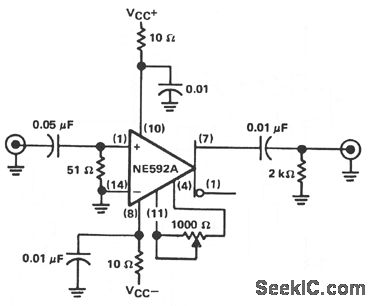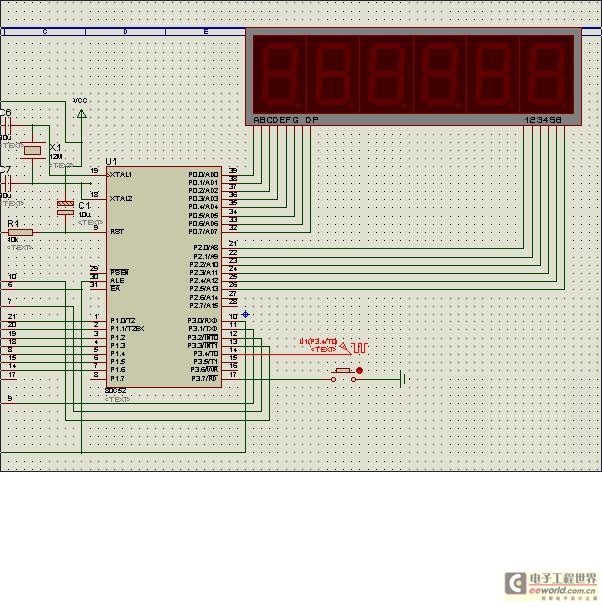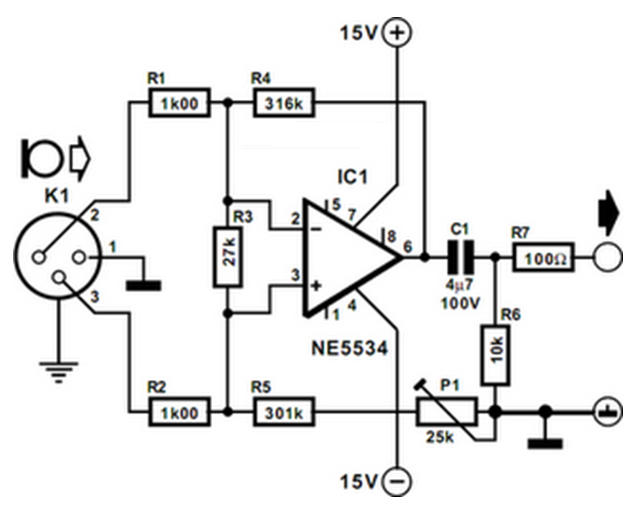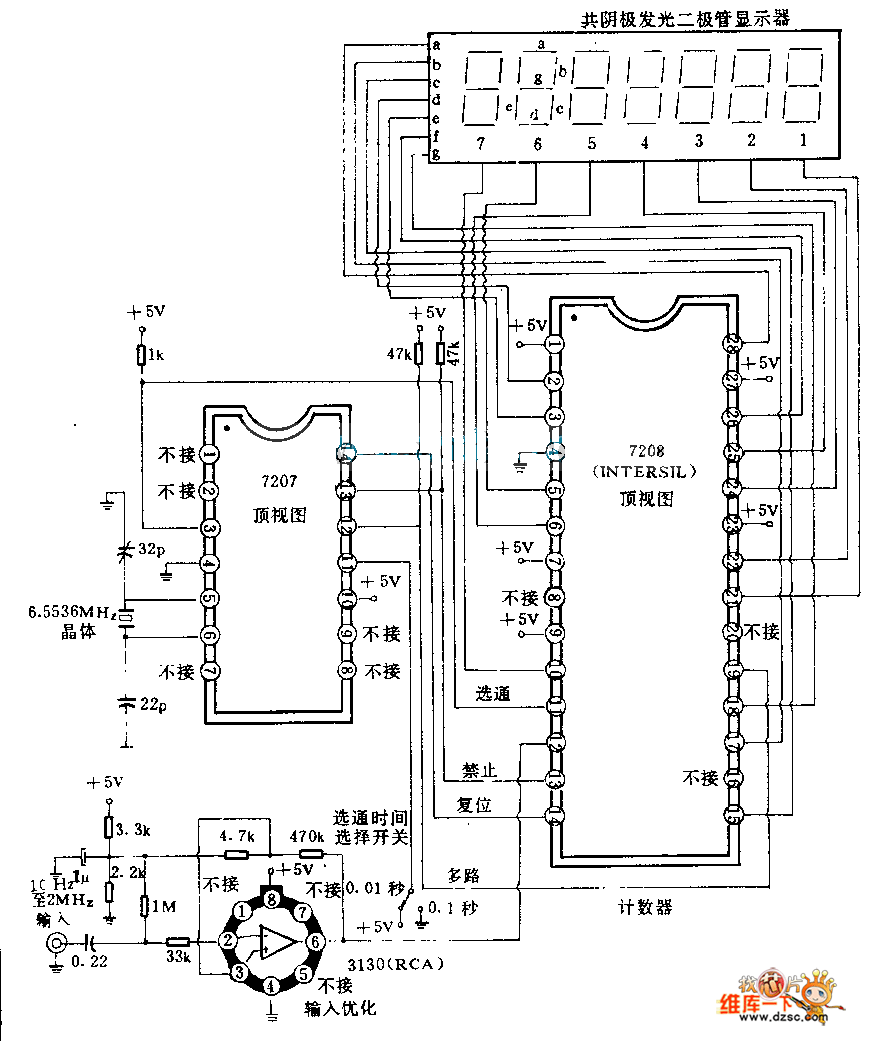
OSCILLOSCOPE COUNTER PREAMPLIFIER

The circuit provides a voltage gain of 20 ±0.1 dB within a frequency range of 500 kHz to 50 MHz. The low-frequency response of the amplifier can be enhanced by increasing the value of the 0.05 µF capacitor connected in series with the input terminal. The circuit achieves an input noise level of approximately 10 µV over a bandwidth of 15.7 MHz. The gain can be calibrated by adjusting the potentiometer connected between pins 4 and 11. A 1 kΩ potentiometer allows for precise adjustment to achieve an exact voltage gain of 10, thereby maintaining the scale factor of the instrument.
The described circuit functions as a high-frequency amplifier, designed to deliver a stable voltage gain while maintaining low noise levels across a specified bandwidth. The gain of 20 ±0.1 dB indicates a well-regulated amplification factor, suitable for applications requiring consistent signal enhancement.
The inclusion of a 0.05 µF capacitor in series with the input terminal is a critical design element, as it influences the low-frequency response of the amplifier. By increasing the capacitance, the circuit can extend its ability to process lower frequency signals, thereby enhancing overall performance in applications where low-frequency fidelity is essential.
The specified input noise level of approximately 10 µV is indicative of a high-quality amplifier, as it suggests minimal interference and signal distortion within the operating bandwidth of 15.7 MHz. This low noise characteristic is crucial for precision applications, such as instrumentation and communication systems, where signal integrity is paramount.
The calibration feature of the circuit is facilitated by a 1 kΩ potentiometer connected between specific pins, allowing for fine-tuning of the gain. This adjustability is essential for ensuring that the amplifier meets the required specifications for various applications, providing flexibility in different operational contexts. The ability to achieve a precise voltage gain of 10 while preserving the scale factor enhances the usability of the instrument, making it suitable for a wide range of electronic measurement tasks.
Overall, this circuit design reflects a careful balance between gain, frequency response, and noise performance, making it a versatile choice for high-frequency amplification needs in electronic systems.The circuit will provide a 20 ±0. 1 dB voltage gain from 500 kHz to 50 MHz. The low-frequency response of the amplifter can be extended by increasing the value of the 0. 05- F capacitor connected in series with the input terminal. This circuit will yield an input-noise level of approximately 10 V over a 1 5. 7-MHz bandwidth. The gain can be catib rated by adjusting the potentiometer connected between pins 4 and 11. The 1-K © potentiometer can be adjusted for an exact voltage gain of 10. This preserves the scale factor of the instrument. 🔗 External reference
The described circuit functions as a high-frequency amplifier, designed to deliver a stable voltage gain while maintaining low noise levels across a specified bandwidth. The gain of 20 ±0.1 dB indicates a well-regulated amplification factor, suitable for applications requiring consistent signal enhancement.
The inclusion of a 0.05 µF capacitor in series with the input terminal is a critical design element, as it influences the low-frequency response of the amplifier. By increasing the capacitance, the circuit can extend its ability to process lower frequency signals, thereby enhancing overall performance in applications where low-frequency fidelity is essential.
The specified input noise level of approximately 10 µV is indicative of a high-quality amplifier, as it suggests minimal interference and signal distortion within the operating bandwidth of 15.7 MHz. This low noise characteristic is crucial for precision applications, such as instrumentation and communication systems, where signal integrity is paramount.
The calibration feature of the circuit is facilitated by a 1 kΩ potentiometer connected between specific pins, allowing for fine-tuning of the gain. This adjustability is essential for ensuring that the amplifier meets the required specifications for various applications, providing flexibility in different operational contexts. The ability to achieve a precise voltage gain of 10 while preserving the scale factor enhances the usability of the instrument, making it suitable for a wide range of electronic measurement tasks.
Overall, this circuit design reflects a careful balance between gain, frequency response, and noise performance, making it a versatile choice for high-frequency amplification needs in electronic systems.The circuit will provide a 20 ±0. 1 dB voltage gain from 500 kHz to 50 MHz. The low-frequency response of the amplifter can be extended by increasing the value of the 0. 05- F capacitor connected in series with the input terminal. This circuit will yield an input-noise level of approximately 10 V over a 1 5. 7-MHz bandwidth. The gain can be catib rated by adjusting the potentiometer connected between pins 4 and 11. The 1-K © potentiometer can be adjusted for an exact voltage gain of 10. This preserves the scale factor of the instrument. 🔗 External reference
Warning: include(partials/cookie-banner.php): Failed to open stream: Permission denied in /var/www/html/nextgr/view-circuit.php on line 713
Warning: include(): Failed opening 'partials/cookie-banner.php' for inclusion (include_path='.:/usr/share/php') in /var/www/html/nextgr/view-circuit.php on line 713





